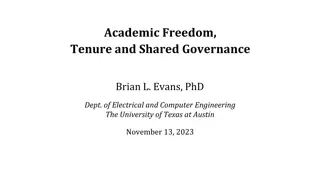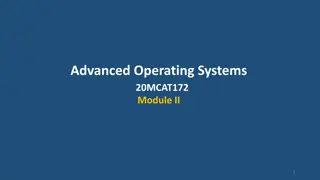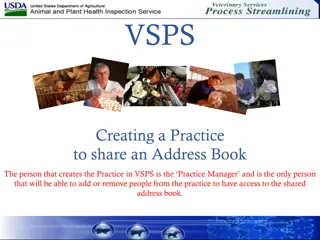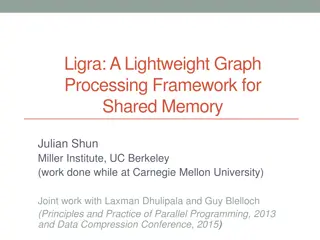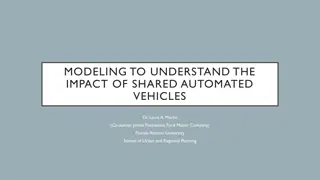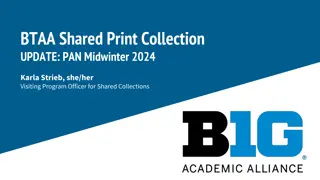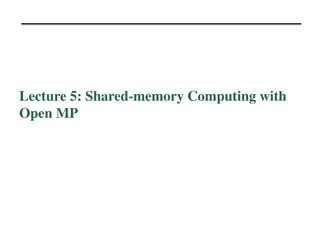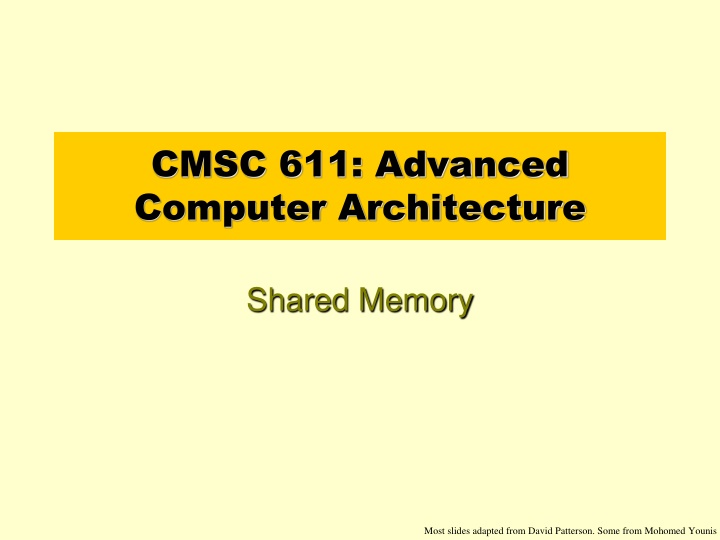
Advanced Computer Architecture: Shared Memory and Message Passing Models
Explore the concepts of shared memory and message passing models in advanced computer architecture, covering topics such as Uniform Memory Access (UMA), Non-Uniform Memory Access (NUMA), advantages of message passing, history of communication methods, shared address space, centralized vs. distributed memory, and more.
Download Presentation

Please find below an Image/Link to download the presentation.
The content on the website is provided AS IS for your information and personal use only. It may not be sold, licensed, or shared on other websites without obtaining consent from the author. If you encounter any issues during the download, it is possible that the publisher has removed the file from their server.
You are allowed to download the files provided on this website for personal or commercial use, subject to the condition that they are used lawfully. All files are the property of their respective owners.
The content on the website is provided AS IS for your information and personal use only. It may not be sold, licensed, or shared on other websites without obtaining consent from the author.
E N D
Presentation Transcript
CMSC 611: Advanced Computer Architecture Shared Memory Most slides adapted from David Patterson. Some from Mohomed Younis
2 MIMD Message Passing Shared memory/distributed memory Uniform Memory Access (UMA) Non-Uniform Memory Access (NUMA) Can support either SW model on either HW basis
3 Message passing Processors have private memories, communicate via messages Advantages: Less hardware, easier to design Focuses attention on costly non-local operations
4 Message Passing Model Each PE has local processor, data, (I/O) Explicit I/O to communicate with other PEs Essentially NUMA but integrated at I/O vs. memory system Free run between Send & Receive Send + Receive = Synchronization between processes (event model) Send: local buffer, remote receiving process/port Receive: remote sending process/port, local buffer
5 History of message passing Early machines Local communication Blocking send & receive Later: DMA with non-blocking sends DMA for receive into buffer until processor does receive, and then data is transferred to local memory Later still: SW libraries to allow arbitrary communication
6 Shared Memory Processors communicate with shared address space Easy on small-scale machines Advantages: Model of choice for uniprocessors, small- scale multiprocessor Ease of programming Lower latency Easier to use hardware controlled caching Difficult to handle node failure
7 Centralized Shared Memory Processors share a single centralized (UMA) memory through a bus interconnect Feasible for small processor count to limit memory contention Model for multi-core CPUs
8 Distributed Memory Uses physically distributed (NUMA) memory to support large processor counts (to avoid memory contention) Advantages Allows cost-effective way to scale the memory bandwidth Reduces memory latency Disadvantage Increased complexity of communicating data
9 Shared Address Model Physical locations Each PE can name every physical location in the machine Shared data Each process can name all data it shares with other processes
10 Shared Address Model Data transfer Use load and store, VM maps to local or remote location Extra memory level: cache remote data Significant research on making the translation transparent and scalable for many nodes Handling data consistency and protection challenging Latency depends on the underlying hardware architecture (bus bandwidth, memory access time and support for address translation) Scalability is limited given that the communication model is so tightly coupled with process address space
11 Three Fundamental Issues 1: Naming: how to solve large problem fast what data is shared how it is addressed what operations can access data how processes refer to each other Choice of naming affects code produced by a compiler Just remember and load address or keep track of processor number and local virtual address for message passing Choice of naming affects replication of data In cache memory hierarchy or via SW replication and consistency
12 Naming Address Spaces Global physical address space any processor can generate, address and access it in a single operation Global virtual address space if the address space of each process can be configured to contain all shared data of the parallel program memory can be anywhere: virtual address translation handles it Segmented shared address space locations are named <process number, address> uniformly for all processes of the parallel program
13 Three Fundamental Issues 2: Synchronization: To cooperate, processes must coordinate Message passing is implicit coordination with transmission or arrival of data Shared address additional operations to explicitly coordinate: e.g., write a flag, awaken a thread, interrupt a processor
14 Three Fundamental Issues 3: Latency and Bandwidth Bandwidth Need high bandwidth in communication Cannot scale, but stay close Match limits in network, memory, and processor Overhead to communicate is a problem in many machines Latency Affects performance, since processor may have to wait Affects ease of programming, since requires more thought to overlap communication and computation Latency Hiding How can a mechanism help hide latency? Examples: overlap message send with computation, pre- fetch data, switch to other tasks
Centralized Shared Memory MIMD Processors share a single centralized memory through a bus interconnect Memory contention: Feasible for small # processors Caches serve to: Increase bandwidth versus bus/memory Reduce latency of access Valuable for both private data and shared data Access to shared data is optimized by replication Decreases latency Increases memory bandwidth Reduces contention Reduces cache coherence problems 15
16 Cache Coherency A cache coherence problem arises when the cache reflects a view of memory which is different from reality Cache Contents for CPU A 0 1 CPU A reads X 2 CPU B reads X 3 CPU A stores 0 into X Cache Contents for CPU B 1 1 Memory Contents for location X 1 1 1 0 Time Event 1 1 0 A memory system is coherent if: P reads X, P writes X, no other processor writes X, P reads X Always returns value written by P P reads X, Q writes X, P reads X Returns value written by Q (provided sufficient W/R separation) P writes X, Q writes X Seen in the same order by all processors
Potential HW Coherency Solutions Snooping Solution (Snoopy Bus) Send all requests for data to all processors Processors snoop to see if they have a copy and respond accordingly Requires broadcast, since caching information is at processors Works well with bus (natural broadcast medium) Dominates for small scale machines (most of the market) 17
Potential HW Coherency Solutions Directory-Based Schemes Keep track of what is being shared in one centralized place Distributed memory distributed directory for scalability (avoids bottlenecks) Send point-to-point requests to processors via network Scales better than Snooping Actually existed before Snooping-based schemes 18
19 Basic Snooping Protocols Write Invalidate Protocol: Write to shared data: an invalidate is sent to all caches which snoop and invalidate any copies Cache invalidation will force a cache miss when accessing the modified shared item For multiple writers only one will win the race ensuring serialization of the write operations Read Miss: Write-through: memory is always up-to-date Write-back: snoop in caches to find most recent copy Contents of CPU A s cache 0 0 1 1 Contents of CPU B s cache 0 1 Contents of memory location X 0 0 0 0 1 Processor activity Bus activity CPU A reads X CPU B reads X CPU A writes a 1 to X CPU B reads X Cache miss for X Cache miss for X Invalidation for X Cache miss for X
20 Basic Snooping Protocols Write Broadcast (Update) Protocol (typically write through): Write to shared data: broadcast on bus, processors snoop, and update any copies To limit impact on bandwidth, track data sharing to avoid unnecessary broadcast of written data that is not shared Read miss: memory is always up-to-date Write serialization: bus serializes requests! Contents of CPU A s cache 0 0 1 1 Contents of CPU B s cache 0 1 1 Contents of memory location X 0 0 0 1 1 Processor activity Bus activity CPU A reads X CPU B reads X CPU A writes a 1 to X Write broadcast of X CPU B reads X Cache miss for X Cache miss for X
21 Invalidate vs. Update Write-invalidate has emerged as the winner for the vast majority of designs Qualitative Performance Differences : Spatial locality WI: 1 transaction/cache block; WU: 1 broadcast/word Latency WU: lower write read latency WI: must reload new value to cache
22 Invalidate vs. Update Because the bus and memory bandwidth is usually in demand, write-invalidate protocols are very popular Write-update can causes problems for some memory consistency models, reducing the potential performance gain it could bring The high demand for bandwidth in write- update limits its scalability for large number of processors
23 An Example Snoopy Protocol Invalidation protocol, write-back cache Each block of memory is in one state: Clean in all caches and up-to-date in memory (Shared) OR Dirty in exactly one cache (Exclusive) OR Not in any caches Each cache block is in one state (track these): Shared : block can be read OR Exclusive : cache has only copy, it is write-able, and dirty OR Invalid : block contains no data Read misses: cause all caches to snoop bus Writes to clean line are treated as misses
24 Snoopy-Cache Controller Complications Cannot update cache until bus is obtained Two step process: Arbitrate for bus Place miss on bus and complete operation Split transaction bus: Bus transaction is not atomic Multiple misses can interleave, allowing two caches to grab block in the Exclusive state Must track and prevent multiple misses for one block
25 Example Assumes memory blocks A1 and A2 map to same cache block, initial cache state is invalid
26 Example Assumes memory blocks A1 and A2 map to same cache block
27 Example Assumes memory blocks A1 and A2 map to same cache block
28 Example Assumes memory blocks A1 and A2 map to same cache block
29 Example Assumes memory blocks A1 and A2 map to same cache block
30 Example A1 A1 Assumes memory blocks A1 and A2 map to same cache block
Distributed Directory Multiprocessors Directory per cache that tracks state of every block in every cache Which caches have a block, dirty vs. clean, ... Info per memory block vs. per cache block? + In memory => simpler protocol (centralized/one location) In memory => directory is f(memory size) vs. f(cache size) To prevent directory from being a bottleneck distribute directory entries with memory each tracks of which processor has their blocks 31
32 Directory Protocol Similar to Snoopy Protocol: Three states Shared: Multiple processors have the block cached and the contents of the block in memory (as well as all caches) is up-to-date Uncached No processor has a copy of the block (not valid in any cache) Exclusive: Only one processor (owner) has the block cached and the contents of the block in memory is out-to-date (the block is dirty) In addition to cache state, must track which processors have data when in the shared state usually bit vector, 1 if processor has copy
33 Directory Protocol Keep it simple(r): Writes to non-exclusive data => write miss Processor blocks until access completes Assume messages received and acted upon in order sent Terms: typically 3 processors involved Local node where a request originates Home node where the memory location of an address resides Remote node has a copy of a cache block, whether exclusive or shared No bus and do not want to broadcast: interconnect no longer single arbitration point all messages have explicit responses
34 Example Directory Protocol Message sent to directory causes two actions: Update the directory More messages to satisfy request We assume operations atomic, but they are not; reality is much harder; must avoid deadlock when run out of buffers in network
Directory Protocol Messages 35 Type Read miss P has read miss at A; request data and make P a read sharer Write miss local cache P has write miss at A; request data and make P exclusive owner Invalidate home directory Invalidate shared data at A Fetch home directory Fetch block A home; change A remote state to shared Fetch/invalidate home directory Fetch block A home; invalidate remote copy Data value reply home directory Return data value from home memory Data write back remote cache Write back data value for A SRC local cache DEST home directory MSG P,A home directory P,A remote cache A remote cache A remote cache A local cache D home directory A,D
Cache Controller State Machine States identical to snoopy case Transactions very similar. Miss messages to home directory Explicit invalidate & data fetch requests 36 State machine for CPU requests for each memory block
Directory Controller State Machine Same states and structure as the transition diagram for an individual cache Actions: update of directory state send messages to satisfy requests Tracks all copies of each memory block Sharers set implementation can use a bit vector of a size of # processors for each block 37 State machine for Directory requests for each memory block
38 Example P2: Write 20 to A1 Assumes memory blocks A1 and A2 map to same cache block
39 Example P1 P1 A1 A1 WrMs DaRp A1 Ex {P1} 0 Excl. A1 10 P2: Write 20 to A1 Assumes memory blocks A1 and A2 map to same cache block
40 Example P1 P1 A1 A1 WrMs DaRp A1 Ex {P1} 0 Excl. Excl. A1 A1 10 10 P2: Write 20 to A1 Assumes memory blocks A1 and A2 map to same cache block
41 Example P1 P1 A1 A1 WrMs DaRp A1 Ex {P1} 0 Excl. Excl. A1 A1 10 10 P2 P1 P2 Shar. A1 RdMs Ftch DaRp A1 A1 A1 A1 10 10 10 Shar. 10 10 A1 Shar. A1 A1 Shar. {P1,P2} 10 P2: Write 20 to A1 Write Back Assumes memory blocks A1 and A2 map to same cache block
42 Example P1 A1 0 Excl. Excl. A1 A1 10 10 DaRp P2 P1 P2 P2 P1 Shar. A1 RdMs Ftch DaRp WrMs Inval. A1 A1 A1 A1 A1 A1 10 10 10 Shar. 10 10 10 10 A1 Shar. Excl. A1 A1 A1 Shar. {P1,P2} 10 20 P2: Write 20 to A1 A1 Inv. Excl. {P2} Assumes memory blocks A1 and A2 map to same cache block
43 Example P1 P1 A1 A1 WrMs DaRp A1 Ex {P1} 0 Excl. Excl. A1 A1 10 10 P2 P1 P2 P2 P1 P2 Shar. A1 RdMs Ftch DaRp WrMs Inval. WrMs A1 A1 A1 A1 A1 A2 A1 10 10 10 Shar. 10 10 10 10 0 A1 Shar. Excl. A1 A1 A1 Shar. {P1,P2} 10 20 P2: Write 20 to A1 A1 A2 Inv. Excl. Excl. {P2} {P2} P2 P2 A1 A2 20 0 WrBk DaRp A1 A2 Unca. Excl. {} 20 0 Excl. A2 {P2} 40 Assumes memory blocks A1 and A2 map to same cache block
44 Interconnection Networks Massively processor networks (MPP) Thousands of nodes Short distance (<~25m) Traffic among nodes Local area network (LAN) Hundreds of computers A few kilometers Many-to-one (clients-server) Wide area network (WAN) Thousands of computers Thousands of kilometers
45 ABCs of Networks Rules for communication are called the protocol , message header and data called a "packet" What if more than 2 computers want to communicate? Need computer address field (destination) in packet What if packet is garbled in transit? Add error detection field in packet (e.g., CRC) What if packet is lost? Time-out, retransmit; ACK & NACK What if multiple processes/machine? Queue per process to provide protection
46 Performance Metrics Sender Overhead Transmission time (size bandwidth) Sender (processor busy) Time of Flight Time of Flight Transmission time (size bandwidth) Receiver Overhead Receiver (processor busy) Transport Latency Total Latency Total latency = Sender Overhead+Time of flight +Message size +Receiver overhead Bandwidth Bandwidth: maximum rate of propagating information Time of flight: time for 1st bit to reach destination Overhead: software & hardware time for encoding/decoding, interrupt handling, etc.
47 Network Interface Issues CPU Network Network Where to connect network to computer? Cache consistency to avoid flushes memory bus Low latency and high bandwidth memory bus Standard interface card? I/O bus Typically, MPP uses memory bus; while LAN, WAN connect through I/O bus $ I/O I/O L2 $ Controller Controller Memory Bus I/O bus Memory Bus Adaptor Ideal: high bandwidth, low latency, standard interface
Taxonomy of Parallel Architecture Flynn Categories SISD (Single Instruction Single Data) MIMD (Multiple Instruction Multiple Data) MISD (Multiple Instruction Single Data) SIMD (Single Instruction Multiple Data) 48
49 SISD Uniprocessor
50 MIMD Multiple communicating processes

